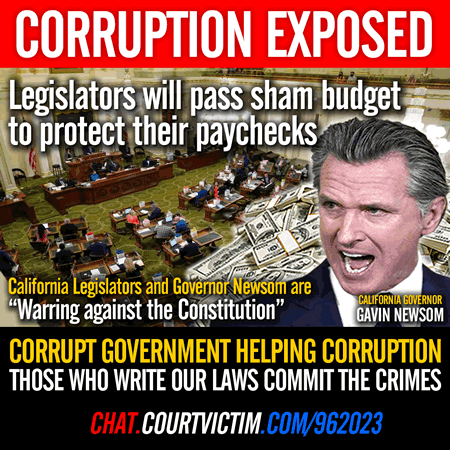A bold headline! What does it mean?
September 6, 2023, is the last day that the California Legislature can amend pending California Assembly Judicial Committee Bill AB 1756, “Omnibus Judicial Legislation” to end thirty-seven (37) years of judicial corruption depriving California citizens and residents due process and an honest judicial system.
The judiciary illegally accepted approximately $1-1.1 billion from California counties and courts, in violation of the California Penal Code’s “bribe” and related sections, and the federal criminal law 18 U.S.C. Section 1346 – “The Intangible Right to Honest Services” under which “Bribery” is an element to prove.
The California Legislature has refused to stop the corruption for thirty-seven (37) years: (1) since 1985 when the “illegal payments” began; (2) 2000 when Richard I. Fine “discovered” the hidden illegal payments and exposed them in court documents; (3) 2008 when the California Court of Appeal held the payments violated the California Constitution; (4) immediately followed by 2009 when the California Judicial Council, the courts and the judges prevailed upon Darryl Steinberg, President pro Tempore of the California State Senate to falsely claim an Emergency Session of the State Legislature and pass SBX 2 11 in seven (7) days to reinstate the illegal payments on an “interim basis” and give the California Superior Court judges who accepted illegal payments and the counties and courts and employees who made the illegal payments, “retroactive immunity from California Criminal Prosecution, Civil Liability and Discipline” which Governor Schwarzenegger immediately signed; (5) 2010 when the California Court of Appeal ruled it was only the Legislature who could stop the illegal payments; and (6) 2015 when the California Court of Appeal again stated it was only the Legislature who could stop the illegal payments.
Commencing in 2020-2021, Richard I. Fine drafted and with others commenced sending draft legislation to the legislators and Governor Newsom, and contacting legislators to stop the illegal payments and the corruption.
The legislators refused to act.
In 2022 through the present, the last draft was sent numerous times and legislators and Governor Newsom were contacted.
The California Legislators and Governor Newsom are “Warring against the Constitution”.
After the draft amendment had been circulated to all the legislators and Governor Newsom, they continued to refuse their duty to even consider it. By acting so: (1) they breached their oath to uphold the U.S. Constitution, including the First Amendment’s “right to petition the Government for a redress of grievances”; and (2) they are “Warring against the Constitution.
See Cooper v. Aaron, 358 U.S. 1, 18 (1958):
“No state legislator or executive or judicial officer can war against the Constitution without violating his undertaking to support it.”
Why is the Draft Legislation and the Legislature’s Refusal Important?
The draft legislation will: (1) remove the existing corruption in the Judicial Branch of the California Government; (2) Create a Permanent State Commission to Oversee the Judicial Branch of the California Government; (3) Compensate the Victims of Judicial Misconduct and Judicial Abuse of Power; (4) Establish Term Limits for Judges and Justices; (5) Prevent any Judge or Justice who received illegal payments from serving in a State elected or Appointed Office; and (6) Establish Retention Elections for all Trial Court Judges who are unopposed in their election to renew their judicial office.
What specifically is the corruption?
The corruption is California counties and courts paying money to the California State Superior (Trial Court) judges in addition to their California state compensation.
The payments are called “supplemental or local judicial benefit payments”. The payments are/or can be 29% or greater of the judge’s annual state compensation.
The payments are: (1) additional health and medical insurance for county employees under the “Cafeteria Plan” or the cash representing such plan; (2) money for educational development, usually $8,000.00 to $9,000.00 annually; and (3) 4-5% of the judge’s State salary paid into the judge’s 401K or 457K retirement plan annually.
The result of these payments added to the judge’s annual State salary places the judge’s annual salary equal to, or higher than, the salary of an Associate Justice of the United States Supreme Court.
These payments are criminal under the California Penal Code as “Bribes” and under 18 U.S.C Section 1346 (the intangible right to honest services.)
These payments were/are approximately $1-1.1 billion illegally paid to approximately 90% of California State Superior Court (Trial Court) judges from 1985 through the present.
How widespread is the corruption?
Over time, these trial court judges became: (1) California Court of Appeal justices and California Supreme Court justices, resulting in the California Court of Appeal and the California Supreme Court also being compromised; and (2) U.S. District Court judges and 9th Circuit Court of Appeal justices, resulting in the U.S. District Courts and the 9th Circuit Courts located in California also being compromised.
How does the “Draft Legislation” relate to Justice in America?
The “Draft Legislation” can be adopted by any State and expanded or reduced to encompass any “local” or State problem.
The “Draft Legislation” can be adopted by the U.S. Congress and expanded or reduced to encompass any federal problems.
Examples for immediate federal adoption to address the most pressing current problems in the current U.S. Supreme Court which are: (1) the U.S. Supreme Court does not have an ethical Code of Conduct to govern its affairs; (2) the U.S. Supreme Court does not have any law resolving the denial of due process to the unopposed Petitions for a Writ of Certiorari in which the facts of denial of due process are clearly shown in the Petition with the controlling U.S. Supreme Court precedents; (3) The U.S. Supreme Court decisions denying petitions for a Writ of Certiorari and Petitions for a rehearing based upon a “denial of due process” do not state reasons, thereby denying many Petitions, which should have been granted.
The “Draft Legislation” can be adopted to address these U.S. Supreme Court problems:
(1) by adding an ethical Code of Conduct to be applied to the United States Supreme Court;
(2) by adding a law stating as follows: “A per curiam decision granting the relief sought in an unopposed Petition for a Writ of Certiorari will be issued if the Petition states: (a) the facts of the alleged due process; and (b) the controlling United States Supreme Court precedent”; and
(3) by adding a law stating: “All decisions denying a Petition for a Writ of Certiorari or a Petition for a rehearing in which a denial of due process is raised, must state reasons for the denial with a controlling United States Supreme Court precedent”.
Conclusion
The American Judicial System is presently held in the lowest level of respect in its history.
Its Constitutional structure remains strong. However, it and the country are in a difficult period of contrasting ideological beliefs preventing the country from uniting for the common good.
Opportunities to move forward are squandered, as demonstrated by the actions of the California legislature which refuses to remove the corruption from the judicial branch of the State government, causing millions of California residents to needlessly suffer.
The same is true in the United States.
The draft legislation hopefully will move the country forward through its recognition of basic problems and developing solutions to those problems which can be adopted both by the states and the country.
Richard I. Fine, Doctor of Law, Ph.D. Law-International Law
Chairman, Campaign for Judicial Integrity; Co-Chairperson, Judicial Reform Committee, DivorceCorp.
Legislators will pass sham budget to protect their paychecks
MORE ON DR. RICHARD I. FINE AND SBX211
THE SOLUTION TO THE PROBLEM







